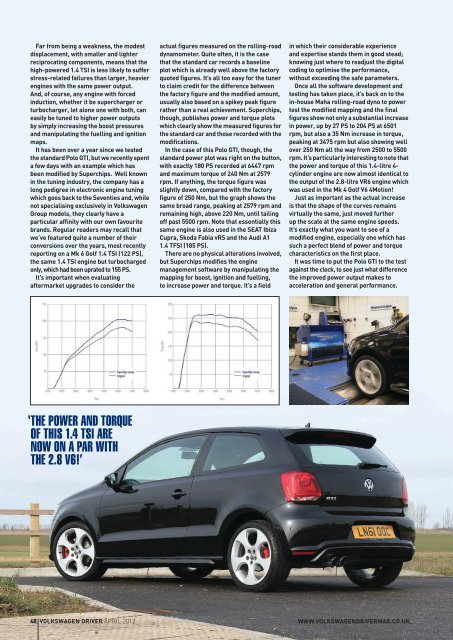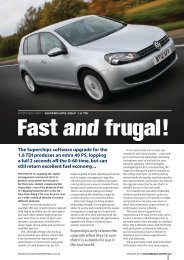Modified cars:Superchips Polo GTI
Modified cars:Superchips Polo GTI
Modified cars:Superchips Polo GTI
You also want an ePaper? Increase the reach of your titles
YUMPU automatically turns print PDFs into web optimized ePapers that Google loves.
far from being a weakness, the modest<br />
displacement, with smaller and lighter<br />
reciprocating components, means that the<br />
high-powered 1.4 TSI is less likely to suffer<br />
stress-related failures than larger, heavier<br />
engines with the same power output.<br />
And, of course, any engine with forced<br />
induction, whether it be supercharger or<br />
turbocharger, let alone one with both, can<br />
easily be tuned to higher power outputs<br />
by simply increasing the boost pressures<br />
and manipulating the fuelling and ignition<br />
maps.<br />
It has been over a year since we tested<br />
the standard <strong>Polo</strong> <strong>GTI</strong>, but we recently spent<br />
a few days with an example which has<br />
been modified by <strong>Superchips</strong>. Well known<br />
in the tuning industry, the company has a<br />
long pedigree in electronic engine tuning<br />
which goes back to the Seventies and, while<br />
not specialising exclusively in Volkswagen<br />
Group models, they clearly have a<br />
particular affinity with our own favourite<br />
brands. Regular readers may recall that<br />
we’ve featured quite a number of their<br />
conversions over the years, most recently<br />
reporting on a Mk 6 Golf 1.4 TSI (122 PS),<br />
the same 1.4 TSI engine but turbocharged<br />
only, which had been uprated to 155 PS.<br />
It’s important when evaluating<br />
aftermarket upgrades to consider the<br />
‘ The power and TorQUe<br />
of This 1.4 Tsi are<br />
now on a par wiTh<br />
The 2.8 V6!’<br />
48 VOLKSWAGEN DRIVER APRIL 2012<br />
actual figures measured on the rolling-road<br />
dynamometer. Quite often, it is the case<br />
that the standard car records a baseline<br />
plot which is already well above the factory<br />
quoted figures. It’s all too easy for the tuner<br />
to claim credit for the difference between<br />
the factory figure and the modified amount,<br />
usually also based on a spikey peak figure<br />
rather than a real achievement. <strong>Superchips</strong>,<br />
though, publishes power and torque plots<br />
which clearly show the measured figures for<br />
the standard car and those recorded with the<br />
modifications.<br />
In the case of this <strong>Polo</strong> <strong>GTI</strong>, though, the<br />
standard power plot was right on the button,<br />
with exactly 180 PS recorded at 6447 rpm<br />
and maximum torque of 240 Nm at 2579<br />
rpm. If anything, the torque figure was<br />
slightly down, compared with the factory<br />
figure of 250 Nm, but the graph shows the<br />
same broad range, peaking at 2579 rpm and<br />
remaining high, above 220 Nm, until tailing<br />
off past 5500 rpm. Note that essentially this<br />
same engine is also used in the SEAT Ibiza<br />
Cupra, Skoda fabia vRS and the Audi A1<br />
1.4 TfSI (185 PS).<br />
There are no physical alterations involved,<br />
but <strong>Superchips</strong> modifies the engine<br />
management software by manipulating the<br />
mapping for boost, ignition and fuelling,<br />
to increase power and torque. It’s a field<br />
in which their considerable experience<br />
and expertise stands them in good stead;<br />
knowing just where to readjust the digital<br />
coding to optimise the performance,<br />
without exceeding the safe parameters.<br />
Once all the software development and<br />
testing has taken place, it’s back on to the<br />
in-house Maha rolling-road dyno to power<br />
test the modified mapping and the final<br />
figures show not only a substantial increase<br />
in power, up by 27 PS to 204 PS at 6501<br />
rpm, but also a 35 Nm increase in torque,<br />
peaking at 3475 rpm but also showing well<br />
over 250 Nm all the way from 2500 to 5500<br />
rpm. It’s particularly interesting to note that<br />
the power and torque of this 1.4-litre 4cylinder<br />
engine are now almost identical to<br />
the output of the 2.8-litre VR6 engine which<br />
was used in the Mk 4 Golf V6 4Motion!<br />
Just as important as the actual increase<br />
is that the shape of the curves remains<br />
virtually the same, just moved further<br />
up the scale at the same engine speeds.<br />
It’s exactly what you want to see of a<br />
modified engine, especially one which has<br />
such a perfect blend of power and torque<br />
characteristics on the first place.<br />
It was time to put the <strong>Polo</strong> <strong>GTI</strong> to the test<br />
against the clock, to see just what difference<br />
the improved power output makes to<br />
acceleration and general performance.<br />
WWW.VOLKSWAGENDRIVERMAG.CO.UK




